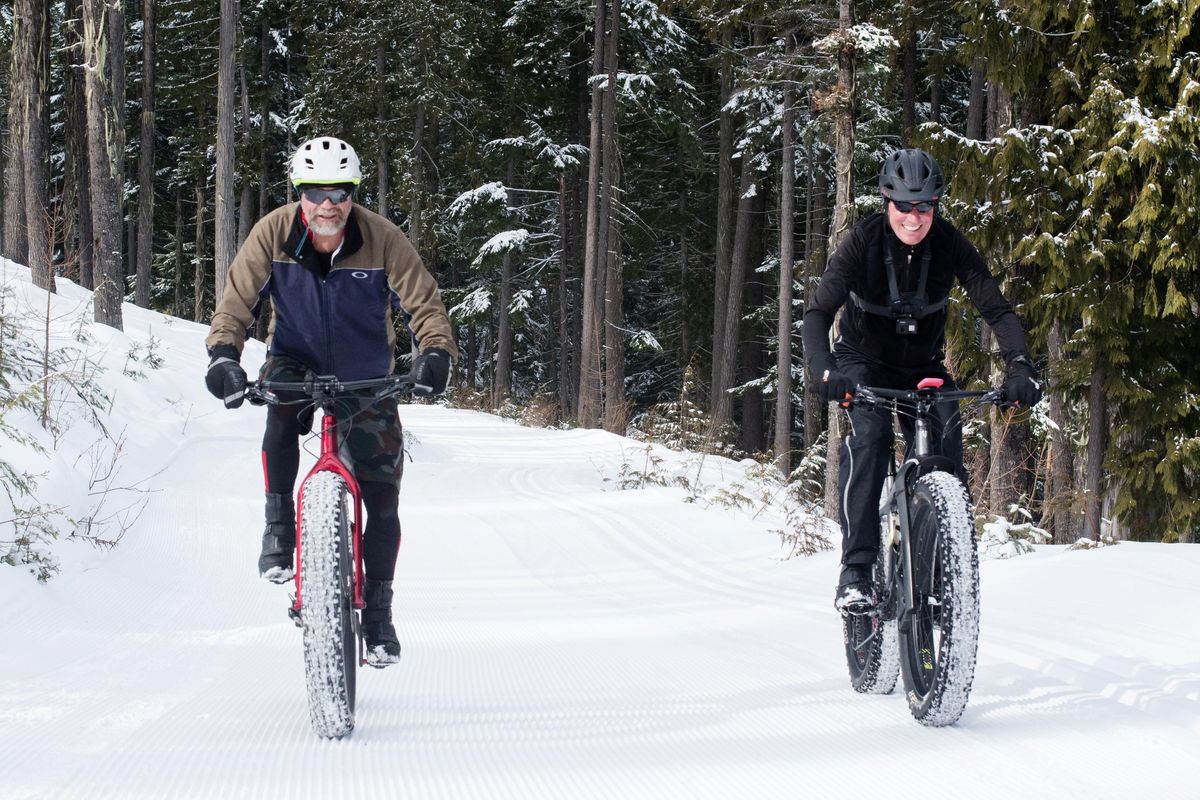From the fringe to the mainstream, fat bikes are here and trails are booming

It’s sunny, 5 new inches of snow blanket the earth and I’m riding a fat-tired bike through the woods working harder than I’d like to admit to keep up with my guides.
We’re riding at 49 Degrees North following trails groomed for cross-country skiers. My guides, Frank Benish and Brent Schlangen, make it look easy, but my legs tell a different story.
The wide tires (a fatbike is defined as a bike with 3.8-inch or wider tires) are great for rolling over rocks or peddling on snow. But it also means you work harder for each foot of forward movement.
It’s worth the effort.
After grinding up a hill, being careful to avoid the newly set cross-country ski tracks, we’re rewarded with a crisp downhill ride. Although I initially felt precarious – flashbacks to hitting icy patches while commuting coming to mind – soon I was happily swinging through snowy corners.
“They’re just fun,” Benish said.
He’s right.
When the goofy-looking vehicles first started showing up in Spokane, they were a novelty. David Nelson, an early fat bike adopter, built his first fattie in 2006 (“Nobody made a complete fat bike back then.”)
“Those first couple year it was kind of cool, but it was also kind of a pain in the ass,” Nelson said. “You couldn’t come across someone with out them wanting to talk about your bike.”
That’s no longer the case. The region’s fat biking scene has “exploded,” Nelson said.
“It’s become very mainstream,” he said. “People see a fat bike now and they don’t think anything of it.”
That’s great for the sport, Wilson and Benish said, and they’re happy to have more riding companions. But it also means a need for more places to ride, particularly in the winter.
“Before, I would basically try to keep track where the big snowshoe group was going for the weekend and I would follow them,” Nelson said. “Or if the military was driving Humvees out at Riverside, that was great.”
Fat bikes need a compacted base of snow, otherwise they’ll flounder. This was evident Monday at 49 Degrees North. Even lightly packed snow crumbled, particularly on uphills, sending my tires punching through and me walking. Groomed cross-country trails make for good riding.
In that way, Benish has pushed the sport forward locally. The retired cement mason has worked with area land managers to groom trails specifically for fat bikes.
Last year, Benish groomed about 10 miles of trail at Riverside State Park. This year, he groomed 20 miles before the snow melted.

Spokane Parks and Recreation has also considered grooming the Dwight Merkel Sports Complex for fat biking, said Ryan Griffith, assistant recreation director for the city. The city has also supported grooming at Riverside State Park.
“It’s a fun sport,” he said. “It definitely opens up biking yearlong.”
Benish also worked out an agreement with 49 Degrees North Nordic center and he’s demonstrated grooming and riding at Mount Spokane’s Nordic area, although fat bikes are still prohibited there.
Since 2013, fat bikers have been riding on Schweitzer Mountain’s Nordic trails.
Last season, Benish bought a small groomer, which he’s uses to set single-track trails. Unlike larger groomers, he can weave through tress and around obstacles making a more varied and exciting riding experience. Wheel Sport has a groomer that Benish also uses.
Benish is in the process of forming a nonprofit, which would allow him to expand the grooming work.
Those efforts, he hopes, will help get another generation of riders into the saddle and onto the snow.
“I’ve never seen anyone that has thrown a leg over a fat bike and didn’t have a big grin on their face,” Nelson said. “They’re comical, but they will go anywhere.”